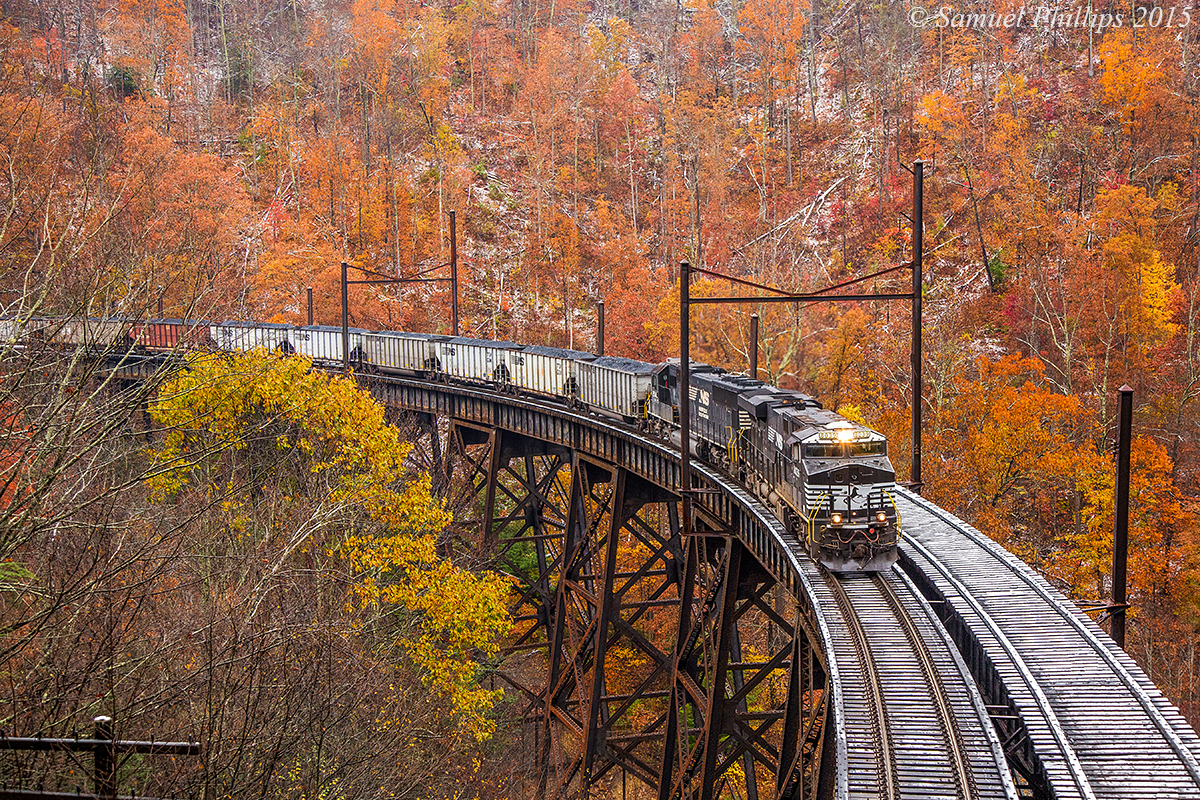
Stunning fall color and trace of snow off set this beautiful scene at Garwood, as train U87 grinds across the trestle with the first of two hill runs going to Clark’s Gap. No. 8039 is leading the charge with one other locomotive in tow. The train is only around 60 loads, hence the 5 locomotive consist.
History of the Virginian Railway
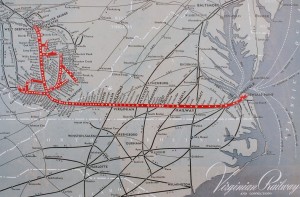 Those of you who follow my photography or previous articles know that I have a fascination with the Virginian Railroad. The railroad is amazing in regards to the territory they overcame and the well-constructed right-of-way that is still utilized by Norfolk Southern today. The Princeton-Deepwater District displays some of the most amazing railroad scenery in Southern West Virginia, and one of the toughest districts on the Pocahontas Division.
Those of you who follow my photography or previous articles know that I have a fascination with the Virginian Railroad. The railroad is amazing in regards to the territory they overcame and the well-constructed right-of-way that is still utilized by Norfolk Southern today. The Princeton-Deepwater District displays some of the most amazing railroad scenery in Southern West Virginia, and one of the toughest districts on the Pocahontas Division.
To those who may not be aware, the Virginian electrified a 133 mile stretch of their mainline between Roanoke, Virginia and Mullens, West Virginia in 1925-26. Thus creating one of the most effective electrified railroad’s in history. Upon completion, it wasn’t long before the Virginian was able to cut their operating costs nearly in half of what it was previously with steam. The electrified stretch of railroad was their busiest section and had some of the steepest grades on the system, with the steepest being Clark’s Gap Grade peaking out around 2%.
Something noteworthy is the Virginian acquired several sets of EL-2B electric locomotives from General Electric in 1948. Operation in pairs, they were rated at 6,800hp and emitting 275,000 pounds of tractive effort, later known as the worlds most powerful electric locomotives.
The Virginian merged with Norfolk & Western in December of 1959 and they shut down the electrification in 1962. Shortly thereafter removing most of the catenary poles and wire along the right-of-way. They still used the Virginian’s fleet of legendary FM Trainmaster diesel locomotives up until the mid-late 70’s when they were retired and scrapped. Some may have thought the Virginian officially died after that. Partly true, but the well-constructed right-of-way with several impressive trestles and magnificent scenery still lives on today. And guess what? Norfolk Southern still conducts present day operations much like the Virginian did back in the day!
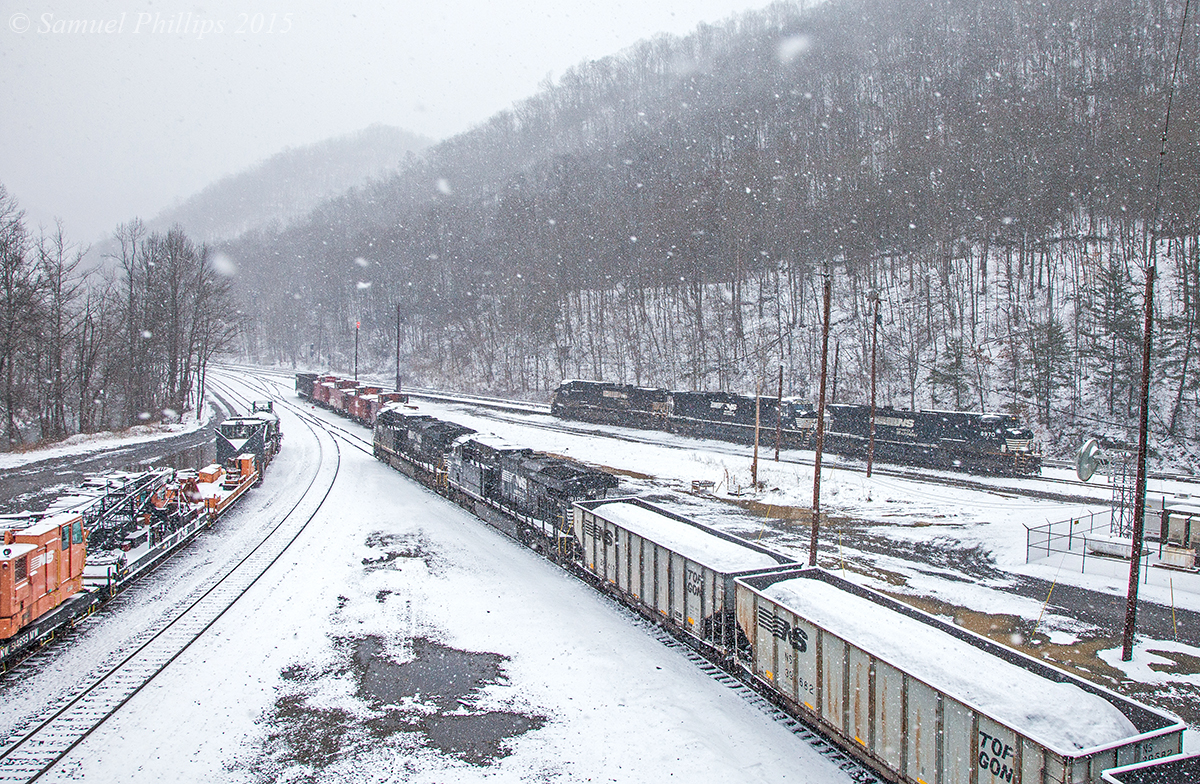
On a blistery winter day, two ES44AC’s lug a cut of 60 loads off the Guyandotte River Branch and onto the P-D mainline at Elmore. The two engines pictured are the pushers and the headend power will soon couple up after they get the train onto the main. Blizzard like conditions will make the the journey the Clark’s Gap very slow and treacherous.
Operations
Since the grade to Clark’s Gap out of Elmore Yard is nearly 2% and the grades east of Clark’s Gap doesn’t top 0.6%, the Virginian would dispatch short coal trains out of Elmore Yard at Mullens and send them upgrade to the small yard at Clark’s Gap where the cars would be dropped and the locomotives would return for another cut of cars to be taken up. The cuts would later be doubled together and sent east to Roanoke. This process called hill runs is still in operation today by NS.
Radio Frequency – 160.440
Train Symbols –
- Deepwater: U90, U91, U92 and extra symbols are U9G, U9E, etc and pusher symbols are: J90, J91.
- Guyandotte River Branch: U80, U81, U82, U83, U84. No pushers needed for any moves on this line.
- Winding Gulf: U93, U94, U95. No pushers need for this line.
- East of Elmore on the P-D mainline: U85, U86, U87, U88, U89 and pushers will be J92, J93, J94, J95. All of the U symbols can be used for hill runs, crews going to the rock load out in Princeton, and empty trains. Basically anything that operates between Elmore and Kellysville on the P-D main can use any of those U85-89 symbols.
Most Direct Road Route* –
- Bluefield, WV – US-52 North to
- Bluewell, WV – WV-71 North to
- Matoaka, WV – WV-10 North to
- WV-16 North
*Main roads that parallel the tracks as often as possible.
In present day operations, NS will usually build a 170-210 car coal train out of Clark’s Gap to be sent to Roanoke. Meaning there will be two hill jobs out of Elmore. One being around a hundred cars and the other being the remaining cars needed for the journey east. There are some utility trains that are loaded on the Virginian and they will not stop at Clark’s Gap to fill out. Rather get shove uphill and continue to Princeton where a Roanoke crew will get on board to take it east.
NS usually dispatches coal trains from Elmore with three locomotives on the headend and three shoving on the rear. The minimum is 5 locomotives, unless the hill run is really short and only needs three or four units.
At Elmore Yard, the Guyandotte River Branch comes up from the south (geographically west) and the mainline to Deepwater continues west. Also at the west end (geographically northeast) of the yard the Winding Gulf Branch splits off from the Deepwater main at Gulf Junction, just to the east of downtown Mullens.
Traffic going east to Clark’s Gap will funnel into the yard off these branches; with the busiest two being the Guyandotte River Branch and the Deepwater line. Elmore usually gets a train a day at a minimum off these lines, with the traffic on the Winding Gulf being more sporadic. Empty trains come into the yard at Elmore with usually 160-200 cars and will be cut into two sections. One going to one mine and the other going somewhere else.
One can expect three to five moves between Elmore and Clark’s Gap in a 12-15 hour period, that includes loads and empties. East of Clark’s Gap to Princeton will be less because 2 hill runs will only make one train east of Weyanoke.
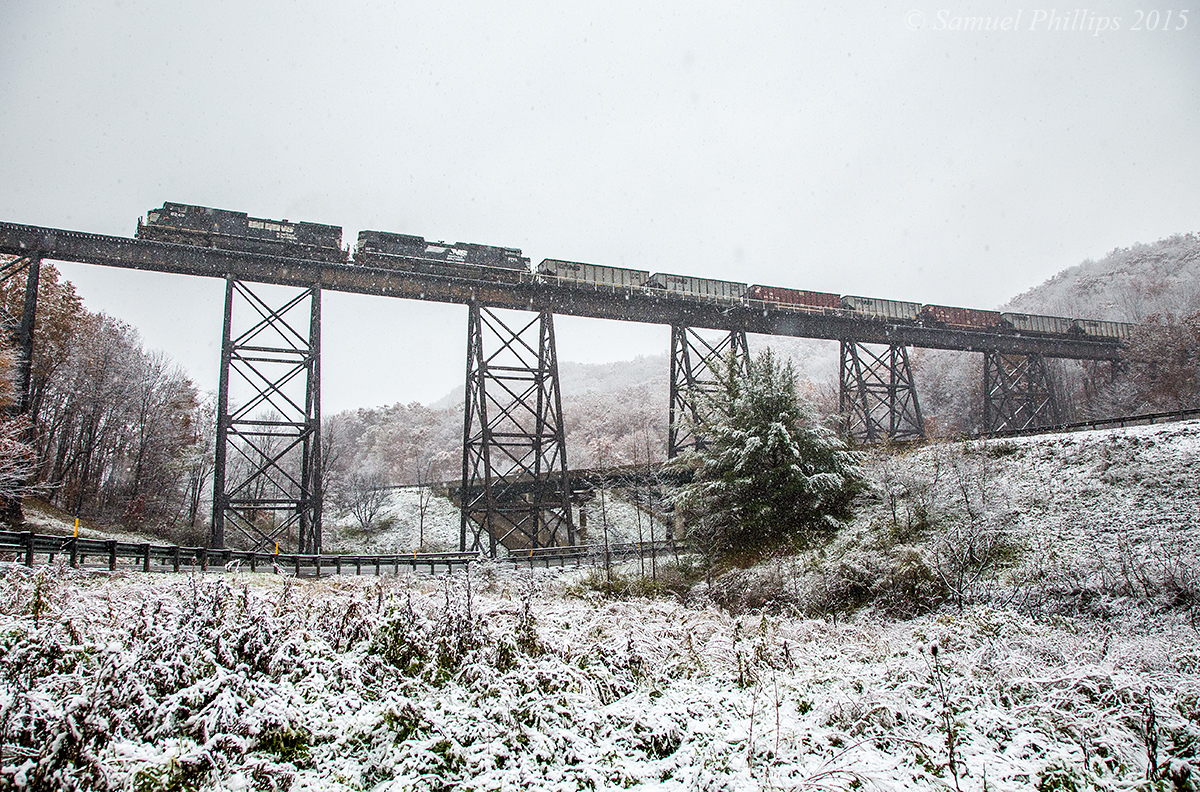
Train U86 with a long string of empties in tow crawls across the trestle at Ingleside soaring high above I-77 with light snow falling. The two locomotives are really struggling to maintain traction with the tough winter conditions making the ascent to Princeton much more difficult than usual.
You can listen in to the PD on 160.440, which is a universal channel for the P-D main and all branches. West of Maben on the Deepwater line and all of the Winding Gulf is track authority territory, so listen in for any trains copying TA’s on these lines.
Driving east of Elmore you’ll find several bridges around Bud and Herndon. All of these make decent shots, especially the first trestle at Bud which still proudly displays old Virginian catenary poles. Trains start hitting the worst of Clark’s Gap grade at Alpoca and will really put on a show from that point forward, only getting better and better the closer it gets to the summit.
The first massive trestle east of Elmore is located at the small town of Covel, which is MP 366. The beautiful curved viaduct makes for beautiful pictures off the shoulder of RT 10, and beneath the trestle in the actual town. There once was a huge mine located on the west end of the trestle, but years of vegetation growth has made it almost impossible to see where it was from the highway.
Garwood, situated at MP 367, is probably the most impressive viaduct on the climb to Clark’s Gap. Soaring across RT 10 at nearly 150 feet in the air, the old trestle proudly displays VGN catenary poles and tunnel No. 9 just east of trestle. Many shots have been taken at this location over the years, and rightly so because of the location’s beauty. Garwood is a must get spot for any visiting railfan.
East of Garwood the tracks become very hard to access until you reach Weyanoke just west of Matoaka. Weyanoke is the east end of double track that starts 5 miles to the west at Algonquin, with Clark’s Gap being the middle control point. This is where most coal trains stop to fill out before proceeding east. There is several approaches used to fill out, but the most frequent is a hill job will bring a cut of cars up the main and leave them just west of Weyanoke before returning light power to Elmore. The second hill run will come up with another cut and stop just short of Clark’s Gap, the middle crossover, and cut off their lead engines while the pushers hold the train’s air. The lead engines will cross over to main two and run to weyanoke and proceed onto single-track, before acquiring permission to reverse passed the stop signal at Weyanoke to couple onto the head of the first cut of cars. After the engines attach, the pushers will get permission to pass the stop signal at Clark’s Gap, with the conductor riding the east end of the cars, and shove their cut against the first cut, thus creating a monster coal drag for the trip east. The entire process will usually consume a couple hours.
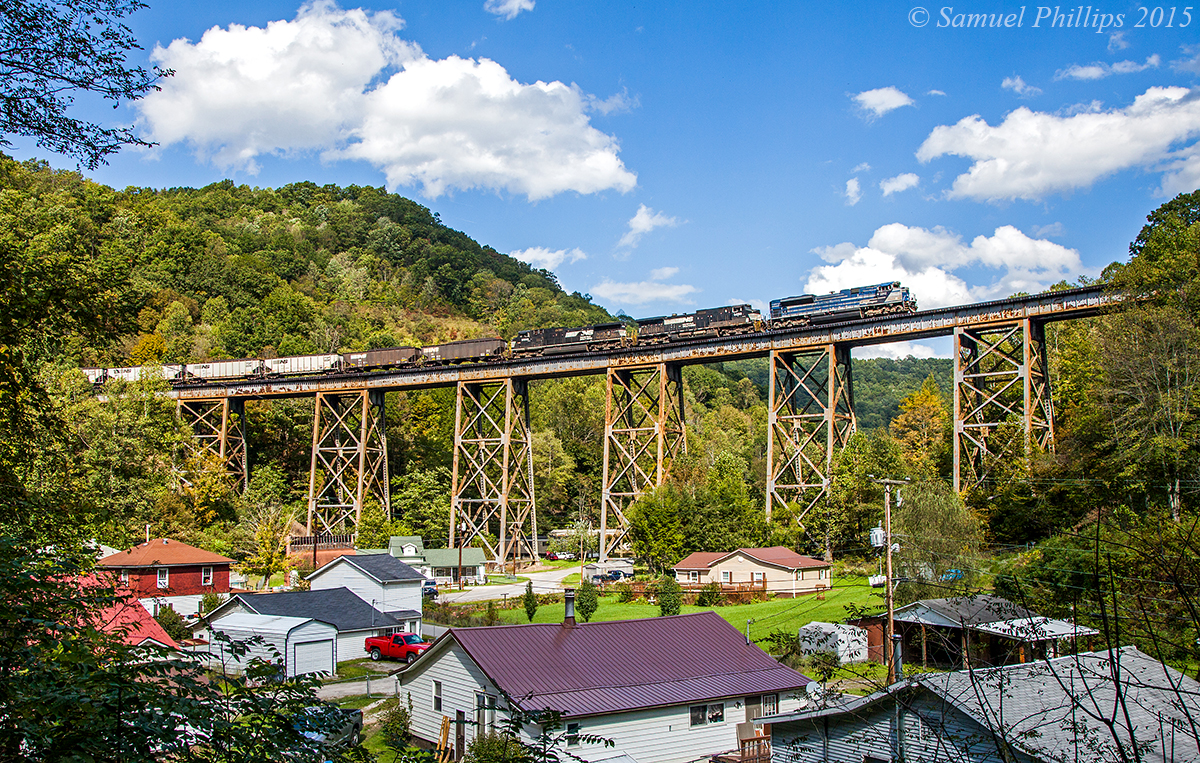
On a beautiful afternoon, train U86 grinds upgrade across the trestle at Covel led by EMDX SD70ACe demonstrator No. 2012 with a utility train in tow en-route to the Belews Creek Steam Staion near Winston-Salem, N.C. Most of the time, trains in this area will only run with NS power, but every now and then, something odd ball like this will pop up and surprise you.
Sometimes a crew change will take place at Weyanoke, but most of the time, a train that filled out will receive a new crew at Princeton. Continuing east of Weyanoke you’ll soon enter the town of Matoaka. This town offers several nice photo locations including the last original Virginian station, which is used as a maintenance of way shed in present times. The N&W’s old Bluestone Branch runs adjacent to the P-D main in downtown Matoaka. Now abandoned, the Bluestone Branch travels south of here to Pokey main at Bluestone, 10 miles west of Bluefield. There is a connection between the P-D and Bluestone Branch located on the west side of the community. If you like shooting detail shots, or photographs of abandoned branches, then Matoaka is a place you’ll love. One could easily spend an hour roaming around the town looking at different aspects.
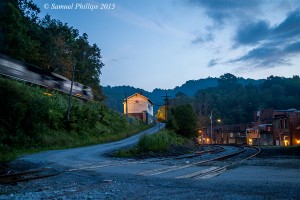
In a late summer blue hour scene, train 845 works west lighting up the old Virginian depot at Matoaka with the Bluestone Branch in the foreground. Matoaka is just one of those fascinating old West Virginia towns that one could spend hours roaming around!
The tracks will leave downtown Matoaka and cross over the Bluestone Branch a short curved viaduct, which makes a super cool image of an eastbound train with the town behind the train. RT 71 will follow the tracks east of Matoaka to a place called Rock, but shots are limited, especially in the summer months. One good shot that is easy to get is the Matoaka Tunnel, situated about 2 miles east of Matoaka. One can pull off the shoulder of RT 71 and get a really nice shot of an eastbound train emerging from the tunnel and crossing a short bridge.
Kegley Trestle is the next must-visit location. The tallest trestle on the entire former Virginian, Black Lick Trestle soars in the air at 200 feet and is nearly 950 feet in length. It is impressive to merely visit this location and look at the beauty of the trestle in person. Eastbound trains will be working really hard because it is a 0.6 ascent. It’s not that much of a grade, but for a train that has filled out and weighs 25-26,000 tons, it is quite the pull!
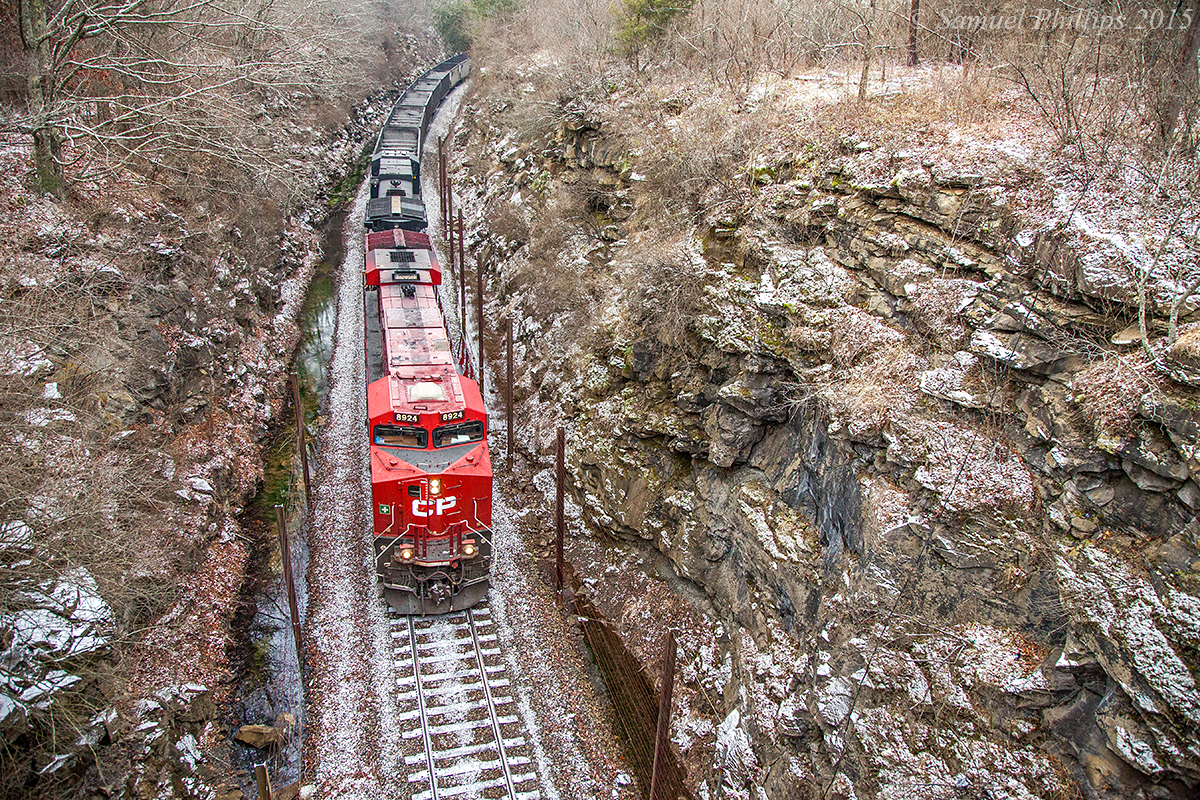
In a beautiful winter scene, train 811 roars upgrade through the deep rock cut at Oney Gap with a visiting Canadian Pacific ES44AC leading the way to Elmore. The train is down to a crawl as the locomotives slip on the snow and ice slickened rail while ascending the 1.5% grade.
After Kegley, you’ll soon arrive in Princeton. This is where trains will likely swap crews and reduce power. East of here, 1 pusher locomotive is all that is needed, and it is there only for dynamic breaking for the 1.5% decent to the N&W mainline to Roanoke at Kellysville. There is also a rock load out here. There is at least 2-4 trains a week loaded here. So it is not uncommon to see something sitting or working the facility. These trains come in from Roanoke, but terminate at the load out.
Princeton has a nice depot and a Virginian caboose, with the signals at Beggs just east of there. As of July 2015 the signals at Beggs are still Virginian searchlight signals, but I don’t know how much longer they will last.
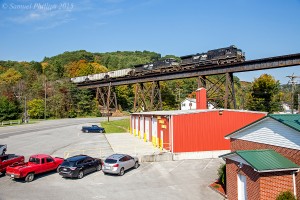
On a beautiful autumn morning, train 810 descends the mountain across the trestle at Oakvale with a freshly painted standard cab C40-9 on the point. The train will soon stop for the J92 pusher to cut off and return to Elmore.
Continuing east, the tracks will cross underneath US 460 and soon pass the signals at Ambrose and enter a deep rock cut. The rock cut at Oney Gap is really neat and its also a place where several publicity shots were taken back in the day. Oney Gap tunnel is just east of the rock cut.
The massive trestle at Ingleside over I-77 is just east of Oney Gap tunnel. One can get cool shots of the trestle taken from the exit ramp from the interstate. The tracks will then proceed into a heavily wooded area that is almost impossible to access. The next access point is Greasy Ridge Rd, 3 miles to the east. The highway will cross underneath a massive trestle. Just west of the bridge is the Ingleside signal and one of the tunnels in the area.
The next town down the mountain is Oakvale. Here you have another trestle over the Oakvale fire department and an old N&W caboose. From here, RT 112 will run adjacent to the Virginian for the next three miles to Kellysville, where the P-D will cross over you and join the ex-N&W Christiansburg District. Loaded trains will stop in this area for its pusher to cut off and return to Elmore.
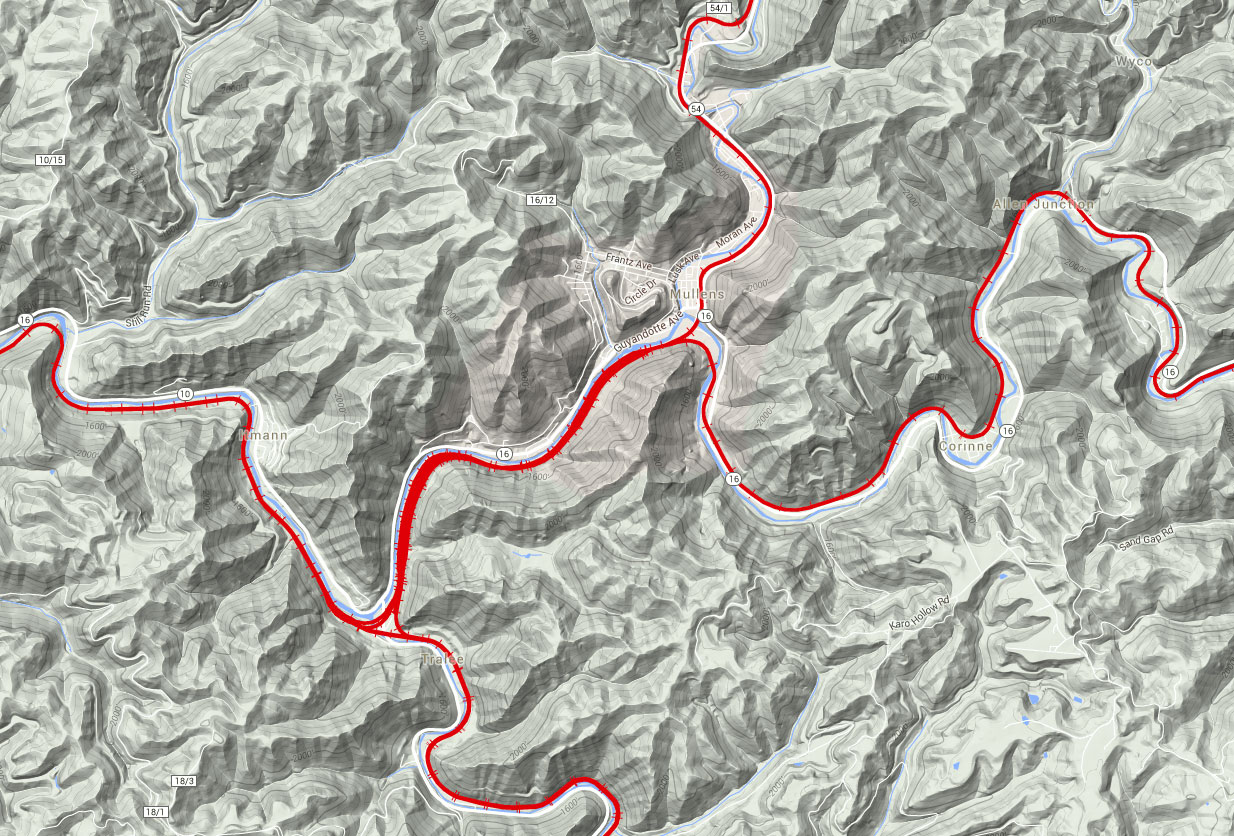
Elmore Yard – Mullens, WV

About the Author
Samuel Phillips is a 19 year old photographer who resides in Radford, Virginia along Norfolk Southern’s mainline to Bluefield and Bristol. He enjoys photographing railroad related subjects the most, but does have interest in portrait photography and occasionally does portrait sessions.
More of his railroad photography can be seen here.
Like and Share with your friends and family!

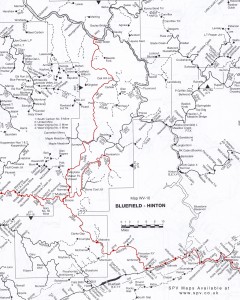
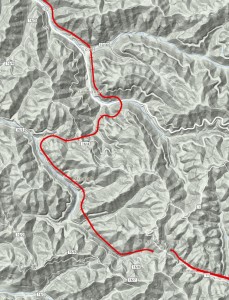
Glenna Rogers
Would it be possible to get a print of the old Virginia depot at Matoaka? My mom grew up there and lived on that mountain. As a child, we travelled past that depot two or three times a year to visit my grandmother. The shot is amazing!
Samuel Phillips
Yes! I would be more than happy to make a print for you! I have several shots at the Motoaka Depot if you would like to pick a favorite from 3 or 4 I have. Email me at samuelkphillips@gmail.com.
Doug
Do you know if the abandoned rails are still intact? Was wondering if you could actually ride on them.